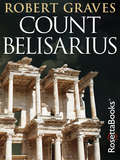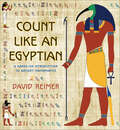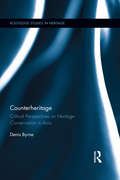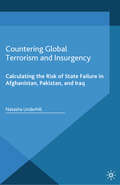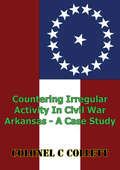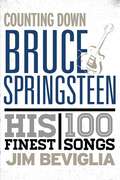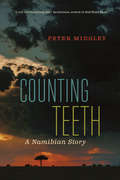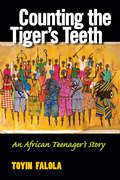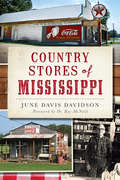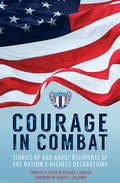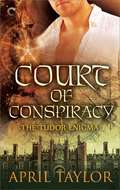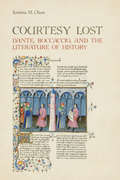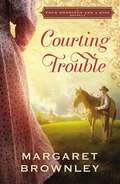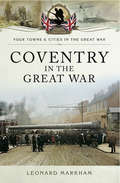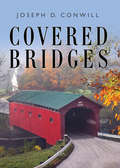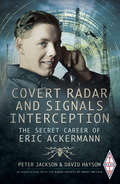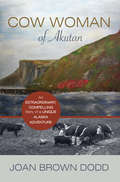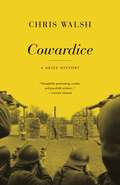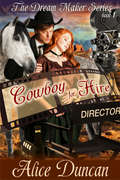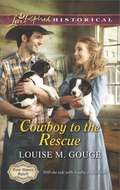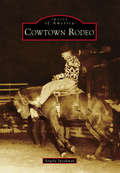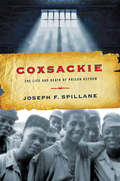- Table View
- List View
Count Belisarius (Modern Classics Ser. #Vol. 65)
by Robert GravesThis &“vigorous tale&” by the acclaimed author of I, Claudius captures the sixth century fall of the Byzantine Empire as seen through the eyes of a servant (Kirkus Reviews). Threatened by invaders on all sides, the Eastern Roman Empire of the sixth century fought to maintain its borders. Leading its defense was the Byzantine general Belisarius, a man who earned the grudging respect of his enemies, and who rose to become Emperor Justinian&’s greatest military leader. Loosely based on Procopius&’s History of the Justinian Wars and Secret History, this novel tells the Belisarius&’s story through the eyes of Eugenius, a eunuch and servant to the general&’s wife. It presents a compelling portrait of a man bound by a strict code of honor and unrelenting loyalty to an emperor who is intelligent but flawed, and whose decisions bring him to a tragic end. Eminent historical novelist and classicist Robert Graves presents a vivid account of a time in history both dissolute and violent, and demonstrates one again his mastery of this historical period. &“A brilliant piece of scholarship.&” —Kirkus Reviews &“The scope of the book is massive—encompassing religious controversy and cultural developments as well as military history—yet, throughout, Graves succeeds in blending historical details with the development of his main characters.&” —Historical Novel Society
Count Like an Egyptian: A Hands-on Introduction to Ancient Mathematics
by David ReimerA lively collection of fun and challenging problems in ancient Egyptian mathThe mathematics of ancient Egypt was fundamentally different from our math today. Contrary to what people might think, it wasn't a primitive forerunner of modern mathematics. In fact, it can’t be understood using our current computational methods. Count Like an Egyptian provides a fun, hands-on introduction to the intuitive and often-surprising art of ancient Egyptian math. David Reimer guides you step-by-step through addition, subtraction, multiplication, and more. He even shows you how fractions and decimals may have been calculated—they technically didn’t exist in the land of the pharaohs. You’ll be counting like an Egyptian in no time, and along the way you’ll learn firsthand how mathematics is an expression of the culture that uses it, and why there’s more to math than rote memorization and bewildering abstraction.Reimer takes you on a lively and entertaining tour of the ancient Egyptian world, providing rich historical details and amusing anecdotes as he presents a host of mathematical problems drawn from different eras of the Egyptian past. Each of these problems is like a tantalizing puzzle, often with a beautiful and elegant solution. As you solve them, you’ll be immersed in many facets of Egyptian life, from hieroglyphs and pyramid building to agriculture, religion, and even bread baking and beer brewing.Fully illustrated in color throughout, Count Like an Egyptian also teaches you some Babylonian computation—the precursor to our modern system—and compares ancient Egyptian mathematics to today’s math, letting you decide for yourself which is better.
Counterheritage: Critical Perspectives on Heritage Conservation in Asia
by Denis ByrneThe claim that heritage practice in Asia is Eurocentric may be well-founded, but the view that local people in Asia need to be educated by heritage practitioners and governments to properly conserve their heritage distracts from the responsibility of educating oneself about the local-popular beliefs and practices which constitute the bedrock of most people’s engagement with the material past. Written by an archaeologist who has long had one foot in the field of heritage practice and another in the academic camp of archaeology and heritage studies, Counterheritage is at once a forthright critique of current heritage practice in the Asian arena and a contribution to this project of self-education. Popular religion in Asia – including popular Buddhism and Islam, folk Catholicism, and Chinese deity cults – has a constituency that accounts for a majority of Asia’s population, making its exclusion from heritage processes an issue of social justice, but more pragmatically it explains why many heritage conservation programs fail to gain local traction. This book describes how the tenets of popular religion affect building and renovation practices and describes how modernist attempts to suppress popular religion in Asia in the early and mid-twentieth century impacted religious ‘heritage.’ Author Denis Byrne argues that the campaign by archaeologists and heritage professionals against the private collecting and ‘looting’ of antiquities in Asia largely ignores the regimes of value which heritage discourse has helped erect and into which collectors and local diggers play. Focussing on the Philippines, Thailand, and Taiwan but also referencing China and other parts of Southeast Asia, richly detailed portraits are provided of the way people live with ‘old things’ and are affected by them. Narratives of the author’s fieldwork are woven into arguments built upon an extensive and penetrating reading of the historical and anthropological literature. The critical stance embodied in the title ‘counterheritage’ is balanced by the optimism of the book’s vision of a different practice of heritage, advocating a view of heritage objects as vibrant, agentic things enfolded in social practice rather than as inert and passive surfaces subject to conservation.
Countering Global Terrorism and Insurgency: Calculating The Risk Of State-failure In Afghanistan, Pakistan And Iraq (New Security Challenges)
by Natasha UnderhillExplores current debates around religious extremism as a means to understand and re-think the connections between terrorism, insurgency and state failure. Using case studies of Pakistan, Afghanistan and Iraq, she develops a better understanding of the underlying causes and conditions necessary for terrorism and insurgency to occur.
Countering Irregular Activity In Civil War Arkansas - A Case Study
by Colonel C. CollettCivil War Arkansas endured many forms of irregular or guerilla warfare including activity that approached insurgency. It was a complex arena that resembles the present day and it illustrates much of contemporary counterinsurgency doctrine.Arkansas was a Southern state with a significant Unionist population and this divide fueled and shaped much of the conflict. Arkansas was unique in that the Confederate commander seeking to make up for conventional weakness, initiated guerilla warfare directed at Union forces. In response, Union commanders who were merely to protect lines of communication responded with punitive actions against individuals and communities which did little to reduce guerilla activity and served to alienate the local population.As the war progressed, however, guerilla bands shifted from military targets becoming progressively more terrorist, criminal, and once a Unionist state government was installed, insurgent. The Union army's role also changed as the main war moved on from the Mississippi basin and Arkansas became an early field for Lincoln's plan to reincorporate rebel states. The army's emphasis thus shifted to extending Federal authority and its organization and tactics evolved into a successful combination of locally raised troops, intelligence led operations, isolation of the guerillas, and political reconciliation.
Counting Down Bruce Springsteen: His 100 Finest Songs
by Jim BevigliaThis ultimate playlist for fans of the Boss &“makes for great debate among friends&” (Asbury Park Press). For decades, Bruce Springsteen has held center stage as the quintessential American rock and roll artist, expressing the hopes and dreams of the American everyman (and woman) through his vast array of insightful and inspirational songs. In Counting Down Bruce Springsteen, rock writer Jim Beviglia dares to rank his finest songs in descending order from the 100th to his #1 greatest song. He also reflects on why each song has earned its place on the list, and lays out the story behind each of the 100, supplying fresh insights on the musical and lyrical content of Springsteen&’s remarkable body of work—in a compelling read for the diehard fan or the newbie just getting acquainted with the Boss. &“Many of Springsteen&’s most popular songs are here, and rightly so, but so are just as many of his obscure ones . . . Of course, Springsteen fans will shake their collective heads in disagreement at times, but that&’s part of the fun.&” —Booklist &“Beviglia has created so much more than a list . . . If you have ever seen Springsteen perform live in concert, those musical memories will all come rushing back as your turn the pages.&” —Osceola News Gazette
Counting Teeth: A Namibian Story
by Peter MidgleyWith his 19-year-old daughter, a collection of maps, and the help of an opinionated GPS, Peter Midgley sets out across Namibia. Visiting small-town museums and gravesites, crossing border checkpoints, and changing tires, they travel the length and breadth of the country uncovering every facet of it. Stories about Portuguese explorers and the first genocide of the 20th century collect on the back seat of their car alongside the author's earliest childhood memories of growing up in the country. By the end of the journey, the stories piece together into an understanding of present-day Namibia and make it possible for Midgley to share his love for this complicated, vibrant place with his daughter.
Counting The Tiger's Teeth: An African Teenager's Story
by Toyin FalolaCounting the Tiger's Teeth narrates a crucial turning point in Nigerian history, the Agbekoya rebellion ("Peasants Reject Poverty") of 1968-70, as chronicled by Toyin Falola, reflecting on his firsthand experiences as a teenage witness to history. Falola, the foremost scholar of Africa of this generation, illuminates the complex factors that led to this armed conflict and details the unfolding of major events and maneuvers. The narrative provides unprecedented, even poetic, access to the social fabric and dynamic cosmology of the farming communities in rebellion as they confronted the modernizing state. The postcolonial government exercised new modes of power that corrupted or neglected traditional forms of authority, ignoring urgent pleas for justice and fairness by the citizenry. What emerges, as the rural communities organized for and executed the war, is a profound story of traditional culture's ingenuity and strength in this epic struggle over the future direction of a nation. Falola reveals the rebellion's ambivalent legacy, the uncertainties of which inform even the present historical moment. Like Falola's prizewinning previous memoir, A Mouth Sweeter Than Salt, this engagingly written book performs the essential service of providing a way of walking with ancestors, remembering the dead, reminding the living, and converting orality into a permanent text.
Country Stores of Mississippi
by June Davis DavidsonThe old country stores along the back roads of rural Mississippi are the treasures that remain of a bygone era. Travel back to the Mississippi of yesteryear and hear of the deadly can of molasses that once caused a massacre in Carrollton, Mississippi, in the late 1800s. Find the church near Alston's General Store in Rodney with a Civil War cannonball lodged in its front facade. Or discover the haunts of Causeyville General Store among shelves and corners stocked with relics of the American past. These and other stores remembered here by local author June Davis Davidson were the cornerstones of their communities, and harken back to a time when the sweetest things in life were the smell of peanuts roasting and reaching into the penny candy jar.
Courage in Combat: Stories by and about Recipients of the Nation's Highest Decorations
by Richard J. RinaldoThese stories of military heroism, focusing on members of the Legion of Valor, offer a sweeping study of courage in service to America. Published in conjunction with the Legion of Valor of the United States of America, Courage in Combat shares the stories of military heroes from the Civil War onward. They are recipients of the Medal of Honor, the Distinguished Service Cross, the Navy Cross, and the Air Force Cross. Their awards are our nation&’s highest military decorations, given only to one in twenty thousand combatants. Among them are sergeants and generals, as well as corpsmen, civilians, engineers, &“grunts,&” and paratroopers. There are men and women, a mess attendant, aviators, spies and POWs, a cavalry scout, candidates for sainthood, and a president of the United States. The stories of these brave individuals relate personal accounts of heroism, as well as reflections on combat and war. This book also includes a short history of the Legion of Valor, America&’s oldest military service organization, and an extensive list of its members, past and present. Courage in Combat explores the concept of courage through the lives, thoughts, and actions of this elite group—most of whom would say, &“I was just doing my job.&”
Court of Conspiracy
by April TaylorBook one of The Tudor EnigmaEngland is the prize. The death of a young king is the price.King Henry IX, son of Henry VIII and Anne Boleyn, holds the very balance of European power in his Protestant hands. His numerous Catholic enemies have cast greedy eyes upon his crown and will stop at nothing to usurp the throne.An unassuming apothecary in the Outer Green of Hampton Court Palace is the Queen's last hope.Luke Ballard treats the poor with balms and salves but is careful to protect his greater gifts. For Luke is also an elemancer, one of the blessed few able to harness elemental powers for good. His quiet life ends when Queen Anne commands him to hunt down the traitors, a mission he cannot refuse.Beset on all sides, Luke mobilizes his arsenal of magic and ingenuity to conquer the enemy. But as the stakes are raised in the uneven battle of good vs. evil, he knows this is only the first skirmish of a lifelong war. The welfare of the Tudors-and England-depends on him alone.102,000 words
Courtesy Lost
by Kristina Marie OlsonIn Courtesy Lost, Kristina M. Olson analyses the literary impact of the social, political, and economic transformations of the fourteenth century through an exploration of Dante's literary and political influence on Boccaccio. The book reveals how Boccaccio rewrote the past through the lens of the Commedia, torn between nostalgia for elite families in decline and the need to promote morality and magnanimity within the Florentine Republic.By examining the passages in Boccaccio's Decameron, De casibus, and Esposizioni in which the author rewrites moments in Florentine and Italian history that had also appeared in Dante's Commedia, Olson illuminates the ways in which Boccaccio expressed his deep ambivalence towards the political and social changes of his era. She illustrates this through an analysis of Dante's and Boccaccio's treatments of the idea of courtesy, or cortesia, in an era when the chivalry of the declining aristocracy was being supplanted by the civility of the rising merchant classes.
Courting Trouble
by Margaret BrownleyIt's 1885 and five preachers sit around a campfire out West, trading stories of unlikely couples they've seen God bring together. This is one of those stories . . .He's a wild-West attorney and she's his beautiful client. Could she really be guilty of murder?Attorney Brock Daniels meets Grace Davenport in the least romantic setting he could imagine: the town jail. And yet her beauty and kindness capture his heart almost from the start.But Grace is facing a tough "jury" in this rough-and-tumble town. And the charges don't look good given her track record. This last one makes her a widow three times over, with each of her dead husbands worse than the last. Geoffrey ate poisoned mushrooms, Harry was so drunk he got thrown by a horse, and Billy Joe went missing after Grace chased him down and gave him what for at the saloon where he'd gambled away all their food money.Still, Brock is a skilled attorney. And Grace's son Jesse is determined to prove her innocence through researching case law at Brock's side until his mom is freed. In the end, Brock may be meeting Grace in front of a judge for an altogether more celebratory occasion . . . as soon as she's cleared."A delightfully romantic tale." --Maggie Brendan, author of The Jewel of His Heart (on "And Then Came Spring" in A Bride for All Seasons)"Brownleyhas a way with words that keeps the reader interested until the last page." --Romantic Times
Coventry in the Great War (Your Towns & Cities in the Great War)
by Leonard MarkhamDuring World War One, the city of Coventry was a powerhouse that kept the barrels loaded and the engines of war purring. An industrial giant, Coventry produced munitions by the million and built tanks, aircraft and fighting vehicles of every description. It never slept.Coventry in the Great War commemorates the centenary of the outbreak of the conflict in 1914, telling the dour and ungilded story of the people who laboured and endured for over four grueling years. This eclectic narrative of the lives of city residents and incomers alike is juxtaposed with often-bloody accounts from the many theatres of war to give a representative and nuanced picture of one of the darkest chapters in world history. The 100th anniversary of the firing of the first fateful bullet is not a time for celebration but rather an opportunity for quiet reflection and studied lesson learning. The 2,599 men of Coventry who died in the cause of freedom deserve no less. During the First World War, the advanced state of the machine tooling industry in the city meant that pre-war production could quickly be turned to war production purposes, with the Coventry Ordnance Works assuming the role of one of the leading production centres in the UK, manufacturing a quarter of all British aircraft produced during the war.But the experience of war also impacted on the inhabitants of the area, from the initial enthusiasm for sorting out the German Kaiser in time for Christmas 1914, to the gradual realization of the enormity of human sacrifice the families of Coventry were committed to as the war stretched out over the next four years. The Great War affected everyone. At home there were wounded soldiers in military hospitals, refugees from Belgium and later on German prisoners of war. There were food and fuel shortages and disruption to schooling. The role of women changed dramatically and they undertook a variety of work undreamed of in peacetime. Extracts from contemporary letters reveal their heroism and give insights into what it was like under battle conditions.
Covered Bridges
by Joseph ConwillCovered bridges are essential pieces of American and Canadian rural history, gracing the countryside from Oregon to Georgia an north to eastern Canada. In this lavishly illustrated volume Joseph D. Conwill recounts the rich, romantic history of covered bridges as they developed from early timber examples, born out of the traditions of medieval times, into modern structures designed for the motorized traffic of the early twentieth century. Reflecting on the efforts to keep covered bridges in service as the face of the rural landscape is transformed, and the challenge of preserving their historic character while making them safe for modern traffic, Conwill guides the reader across the diverse range of covered bridges to be found throughout North America.
Covert Radar and Signals Interception: The Secret Career of Eric Ackermann
by Peter Jackson David Haysom“A remarkable reconstruction of the extensive and quite exceptional career” of a key WW2 military intelligence officer. (Royal Air Force Historical Society)Of German stock dating back to 1530 in Saxony, Eric George Ackermann GM was born on the Isle of Wight in 1919 and became a leading figure in the world of signals and electronic intelligence. As a Junior Scientific Officer at the Telecommunication Research Establishment, Boscombe Down, with an honorary commission in the Royal Air Force, he made numerous flights over occupied territory searching for, monitoring and destroying Germany’s Wuerzburg, Knickebein and X Band radar systems. Much of his research was passed to the highest levels of wartime government, ensuring that tactical plans could be executed that took full advantage of top secret German intelligence. A host of secret missions to assess the enemy’s radar capabilities were carried out in North Africa, Gibraltar and Italy. This engaging biography explores his operational deployment at the vanguard of tactical intelligence operations during WWII. Winner of the George Medal for conspicuous gallantry, Ackermann also saw conflict up close and personal. After the war, he played a major part in the implementation of a string of listening stations built along the borders of Soviet Bloc countries, which later gleaned a wealth of invaluable post-war intelligence. Further work in aeronautics and satellite construction in the United States followed. Despite Ackermann’s achievements, he has never been the subject of a book-length study until now. Covert Radar and Signals Interception will appeal to aviation enthusiasts, as well as readers curious to gain new insights into twentieth century intelligence practices and their often far-reaching consequences.
Cow Woman of Akutan: An Extraordinary, Compelling Story of a Unique Alaska Adventure
by Joan DoddAs I made my way to the hold, I saw Charlie and Hans lashing the deck cargo down tighter while they, too, struggled against the violent rising and plunging of the boat. Suddenly, despite their efforts, some of the bales of hay and bags of feed slid over the side into the dark churning waters of the Pacific. Crashing waves and roaring wind were so loud I didn't hear them hit the black undulating water; they were just swallowed up. On reaching the hold, I heard cows above the din of the raging storm as they were bellowing in their fear and misery. Cow Woman of Akutan is an incredible account of a family and their partner as they encountered multiple disasters in their attempt to raise livestock on an isolated Aleutian island inhabited by a small group of Alaska Aleuts. Cow Woman of Akutan is a story of survival coupled with multiple events as Akutan villagers often come to the rancher's aid.
Cowardice: A Brief History
by Chris WalshA provocative look at how cowardice has been understood from ancient times to the presentCoward. It's a grave insult, likely to provoke anger, shame, even violence. But what exactly is cowardice? When terrorists are called cowards, does it mean the same as when the term is applied to soldiers? And what, if anything, does cowardice have to do with the rest of us? Bringing together sources from court-martial cases to literary and film classics such as Dante's Inferno, The Red Badge of Courage, and The Thin Red Line, Cowardice recounts the great harm that both cowards and the fear of seeming cowardly have done, and traces the idea of cowardice’s power to its evolutionary roots. But Chris Walsh also shows that this power has faded, most dramatically on the battlefield. Misconduct that earlier might have been punished as cowardice has more recently often been treated medically, as an adverse reaction to trauma, and Walsh explores a parallel therapeutic shift that reaches beyond war, into the realms of politics, crime, philosophy, religion, and love.Yet, as Walsh indicates, the therapeutic has not altogether triumphed—contempt for cowardice endures, and he argues that such contempt can be a good thing. Courage attracts much more of our attention, but rigorously understanding cowardice may be more morally useful, for it requires us to think critically about our duties and our fears, and it helps us to act ethically when fear and duty conflict.Richly illustrated and filled with fascinating stories and insights, Cowardice is the first sustained analysis of a neglected but profound and pervasive feature of human experience.
Cowboy for Hire: 1900s Historical Romance (The Dream Maker Series #1)
by Alice DuncanIt's 1905, early in the Silent Film era, and orphan Amy Wilkes is "discovered" by producer Martin Tafft at a Pasadena Health Spa. Whisked away to the movie-making set, Amy is glamorized and placed before her leading man: a rugged, oh-so-handsome Arizona cowboy named Charlie Fox.Charlie, another "natural", needs money for his ranch, not the naive attentions of a beautiful starlet no matter how far she turns his head.On screen, sparks fly between Amy and Charlie, as the pair struggle to act like people they're not. Off screen, they face the scuttling machinations of the other actors and Charlie realizes what Amy truly dreams of--love and security. He offers her both. But first, Amy must open her heart.AWARDS:Romantic Times KISS AwardREVIEWS:"Alice Duncan's knowledge of the 1900's film era brings a sparkle to COWBOY FOR HIRE. Highly recommended." ~Word Weaving"What a delightful read! Fascinating era... fascinating backdrop... and a lovely romance!" ~Norah Wilson, USA Today bestselling authorTHE DREAM MAKER SERIES, in order Cowboy for HireBeauty and the BrainThe Miner's DaughterHer Leading Man
Cowboy to the Rescue
by Louise M. GougeCaptivated by the cowboy Though Georgia belle Susanna Anders agrees to accompany her father on a silver prospecting trip to Colorado, her heart belongs to the South. Then charming cowboy Nate Northam saves her father's life and gives them shelter at his ranch. Feeling gratitude is only natural, but falling for a Yankee? Both of their families would be outraged. While Susanna's father recovers at the Northams' home, Nate can't help being drawn to the sweet Southern beauty...and wishing he were free to think of courtship. That is until shocking revelations compel both Nate and Susanna to choose where their loyalties lie-fettered to the past or to the promise of a bold new love.... Four Stones Ranch: Love finds a home out West
Cowtown Rodeo (Images of America)
by Angela SpeakmanAn enormous red cow and a 20-foot-tall cowboy have long welcomed all who arrive at the Cowtown Rodeo and Flea Market. In the 1920s, Amos Howard Harris was auctioning automobiles in a livestock town. Realizing he needed to appeal to the locals, he and his son began hosting weekly livestock auctions and inviting local merchants to attend and sell their goods. The idea was a success. In 1929, the Harris family and Cowtown helped revive the local annual fair and rodeo, which continued to exist until World War II. With the popularity of the auction and the growth of the midway market, the operation moved to a larger location in 1940. Then, 15 years later, Cowtown hosted its first full rodeo season. Today, it is the longest continually running weekly professional rodeo in the country. It remains a Harris family business and a South Jersey tradition, attracting visitors from around the world.
Coxsackie: The Life and Death of Prison Reform (Reconfiguring American Political History)
by Joseph F. SpillaneHow progressive good intentions failed at Coxsackie, once a model New York State prison for youth offenders.Should prisons attempt reform and uplift inmates or, by means of principled punishment, deter them from further wrongdoing? This debate has raged in Western Europe and in the United States at least since the late eighteenth century. Joseph F. Spillane examines the failure of progressive reform in New York State by focusing on Coxsackie, a New Deal reformatory built for young male offenders. Opened in 1935 to serve "adolescents adrift," Coxsackie instead became an unstable and brutalizing prison. From the start, the liberal impulse underpinning the prison’s mission was overwhelmed by challenges it was unequipped or unwilling to face—drugs, gangs, and racial conflict.Spillane draws on detailed prison records to reconstruct a life behind bars in which "ungovernable" young men posed constant challenges to racial and cultural order. The New Deal order of the prison was unstable from the start; the politics of punishment quickly became the politics of race and social exclusion, and efforts to save liberal reform in postwar New York only deepened its failures. In 1977, inmates took hostages to focus attention on their grievances. The result was stricter discipline and an end to any pretense that Coxsackie was a reform institution.Why did the prison fail? For answers, Spillane immerses readers in the changing culture and racial makeup of the U.S. prison system and borrows from studies of colonial prisons, which emblematized efforts by an exploitative regime to impose cultural and racial restraint on others.In today’s era of mass incarceration, prisons have become conflict-ridden warehouses and powerful symbols of racism and inequality. This account challenges the conventional wisdom that America’s prison crisis is of comparatively recent vintage, showing instead how a racial and punitive system of control emerged from the ashes of a progressive ideal.
Coxsackie: The Life and Death of Prison Reform (Reconfiguring American Political History)
by Joseph F. Spillane“Even-handed and free of jargon . . . a revealing account of how our criminal justice system operates on the ground level.” —Edward D. Berkowitz, author of Mass AppealJoseph F. Spillane examines the failure of progressive reform in New York State by focusing on Coxsackie, a New Deal reformatory built for young male offenders. Opened in 1935 to serve “adolescents adrift,” Coxsackie instead became an unstable and brutalizing prison. From the start, the liberal impulse underpinning the prison’s mission was overwhelmed by challenges it was unequipped or unwilling to face—drugs, gangs, and racial conflict.Spillane draws on detailed prison records to reconstruct a life behind bars in which “ungovernable” young men posed constant challenges to racial and cultural order. The New Deal order of the prison was unstable from the start; the politics of punishment quickly became the politics of race and social exclusion, and efforts to save liberal reform in postwar New York only deepened its failures. In 1977, inmates took hostages to focus attention on their grievances. The result was stricter discipline and an end to any pretense that Coxsackie was a reform institution.In today’s era of mass incarceration, prisons have become conflict-ridden warehouses and powerful symbols of racism and inequality. This account challenges the conventional wisdom that America’s prison crisis is of comparatively recent vintage, showing instead how a racial and punitive system of control emerged from the ashes of a progressive ideal.“Should be required reading for historians of juvenile and criminal corrections . . . Presents a compelling cautionary tale that contemporary would-be reformers ignore at their peril, while offering important new insights for scholars.” —American Historical Review
Cracking the AP European History Exam, 2015 Edition
by Princeton ReviewEVERYTHING YOU NEED TO SCORE A PERFECT 5. Equip yourself to ace the AP European History Exam with The Princeton Review's comprehensive study guide--including thorough content reviews, targeted strategies for every question type, and 2 full-length practice tests with complete answer explanations. We don't have to tell you how tough AP European History is to remember and analyze--or how important getting a stellar exam score can be to your chances of getting into the top college of your choice. Written by the experts at The Princeton Review, Cracking the AP European History Exam arms you to take on the test with:Techniques That Actually Work.* Tried-and-true strategies to avoid traps and beat the test* Tips for pacing yourself and guessing logically* Essential tactics to help you work smarter, not harderEverything You Need to Know for a High Score.* Comprehensive content review for all test topics* Important information about the upcoming AP European History Courseand Exam changes* Engaging activities to help you critically assess your progressPractice Your Way to Perfection.* 2 full-length practice tests with detailed answer explanations* Practice drills at the end of each content review chapter* Helpful timelines of major developments, plus chapter review questions
Cracking the AP U.S. History Exam 2015 Edition
by The Staff of The Princeton Review Tom Meltzer Jean Hofheimer BennettThe AP U.S. History Exam consists of two main sections: a multiple-choice and short-answer section and an essay questions section.This book is organized to provide as much support and help to improve your score on the AP U.S. History Exam.
